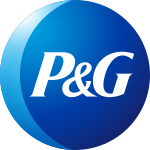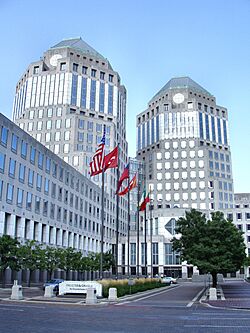- This page was last modified on 17 October 2025, at 10:18. Suggest an edit.
Procter & Gamble facts for kids
"P&G" redirects here. For other uses, see PG.

Secondary logo since 2013, concurrently used with the 2002 lettermark
|
|

Headquarters in Cincinnati
|
|
|
Trade name
|
P&G |
|---|---|
| Public | |
| Traded as | |
| Industry |
|
| Founded | October 31, 1837 |
| Founders |
|
| Headquarters | Cincinnati, Ohio, US |
|
Area served
|
Worldwide |
|
Key people
|
|
| Products |
|
| Brands | See list of Procter & Gamble brands |
| Revenue | |
|
Operating income
|
|
| Total assets | |
| Total equity | |
|
Number of employees
|
109,000 (2025) |
| Subsidiaries |
|
| Footnotes / references Financials as of June 30, 2025[update]. |
|
Logo used from 1992 to 2002.
Primary logo used since 2002 on P&G branded products, formerly used as a corporate logo until 2013.
The Procter & Gamble Company, also known as P&G, is a large American company that makes many products people use every day. It is a corporation that sells consumer goods, which are items bought by people for their own use, not for making other things. The company's main office is in Cincinnati, Ohio.
You have probably seen or used P&G products without even knowing it. The company owns many famous brands. These are grouped into five main areas:
- Beauty: This includes brands like Head & Shoulders, Herbal Essences, Pantene, Olay, and Old Spice.
- Grooming: This group has products for shaving and personal care, like Braun shavers and Gillette razors.
- Health Care: This includes well-known brands like Crest toothpaste, Oral-B toothbrushes, Pepto-Bismol, and Vicks.
- Fabric & Home Care: This is P&G's biggest section, with cleaning brands like Tide laundry detergent, Downy fabric softener, Dawn dish soap, and Febreze air freshener.
- Baby, Feminine & Family Care: This group includes Pampers diapers, Always and Tampax products, Bounty paper towels, and Charmin toilet paper.
Many of these brands are leaders in their markets. P&G sells its products all over the world, with about half of its sales happening outside the United States.
Contents
History
How P&G Started
P&G was started a long time ago, in 1837. It was founded by two men who came to the United States from Europe. William Procter was a candlemaker from England, and James Gamble was a soap maker from Ireland.
They both moved to Cincinnati, Ohio, and happened to marry two sisters. Their father-in-law suggested they should start a business together. They agreed, and Procter & Gamble was born.
By 1859, the company was making $1 million in sales, which was a huge amount of money back then. During the American Civil War, P&G supplied soap and candles to the Union Army. This helped the company grow and also made its products known to soldiers from all over the country.
In the 1880s, P&G created a new soap that was inexpensive and could float in water. They named it Ivory, and it became very popular. Around the same time, William Procter's grandson started a program to share some of the company's profits with the workers. He believed this would make them happier and less likely to go on strike.
Growing Bigger
As more people wanted to buy P&G products, the company built more factories across the United States. They also started making new kinds of products. In 1911, they introduced Crisco, a type of cooking shortening made from vegetable oils instead of animal fats.
P&G was also one of the first companies to use advertising in a big way. They placed large ads in magazines. When radio became popular in the 1920s, P&G started sponsoring radio shows. These shows were often dramas that aired during the day and were nicknamed "soap operas" because a soap company paid for them. P&G continued this tradition when television was invented, producing and sponsoring many TV soap operas for decades.
New Products and Global Reach
In 1930, P&G became an international company when it bought a company in England. Over the years, they kept creating new and innovative products.
- In 1946, they launched Tide laundry detergent.
- In 1955, they introduced Crest, the first toothpaste with fluoride to help fight cavities.
- In 1957, they bought the Charmin paper company and started making toilet paper.
- In 1961, they introduced Pampers, one of the first successful disposable diapers. Before Pampers, most babies wore cloth diapers that had to be washed by hand. Pampers made life much more convenient for parents.
The company continued to grow by buying other companies and their brands. Some of these included Folgers Coffee, Old Spice, Gillette, and Pantene. In 2005, P&G bought Gillette, which made it the largest consumer goods company in the world at the time. This deal added famous brands like Gillette razors, Duracell batteries, and Oral-B to P&G's collection.
Focusing on Top Brands
By 2014, P&G owned hundreds of brands. The company decided to simplify things and focus on its most successful ones. It announced a plan to sell off about 100 of its smaller brands. This allowed P&G to put more effort into the 65 brands that were making most of the company's money.
For example, P&G sold its pet food brand, Iams, and later sold 43 of its beauty brands, including CoverGirl and Max Factor, to the company Coty. It also sold the Duracell battery brand to Berkshire Hathaway. In 2018, P&G bought the consumer health division of a German company called Merck Group, adding more health products to its lineup.
Brands and Products
As of 2015, P&G had 21 brands that each made over a billion dollars in sales every year. Many of these are household names around the world, like Bounty, Crest, and Tide.
The company's products are sold in North America, Latin America, Europe, the Middle East, Africa, Asia, and Australia. P&G has factories in many countries to make these products, including:
Sponsorships and Community
P&G is famous for its advertising, especially its connection to the Olympic Games. Since 2012, P&G has been a major sponsor of the Olympics.
The company is well-known for its "Thank You, Mom" ad campaign. These emotional commercials show the journey of Olympic athletes from childhood to success, highlighting the support of their mothers. The ads have featured famous athletes like skier Lindsey Vonn and figure skater Yuzuru Hanyu.
P&G has also created online communities, such as BeingGirl.com, to connect with its customers.
Awards and Recognition
P&G has received many awards over the years.
- Fortune magazine has named P&G as one of the "World's Most Admired Companies."
- Chief Executive magazine called P&G the best company for developing leaders.
- In 2023, Forbes magazine recognized P&G as one of the World's Most Reputable Companies.
See also
 In Spanish: Procter & Gamble para niños
In Spanish: Procter & Gamble para niños


